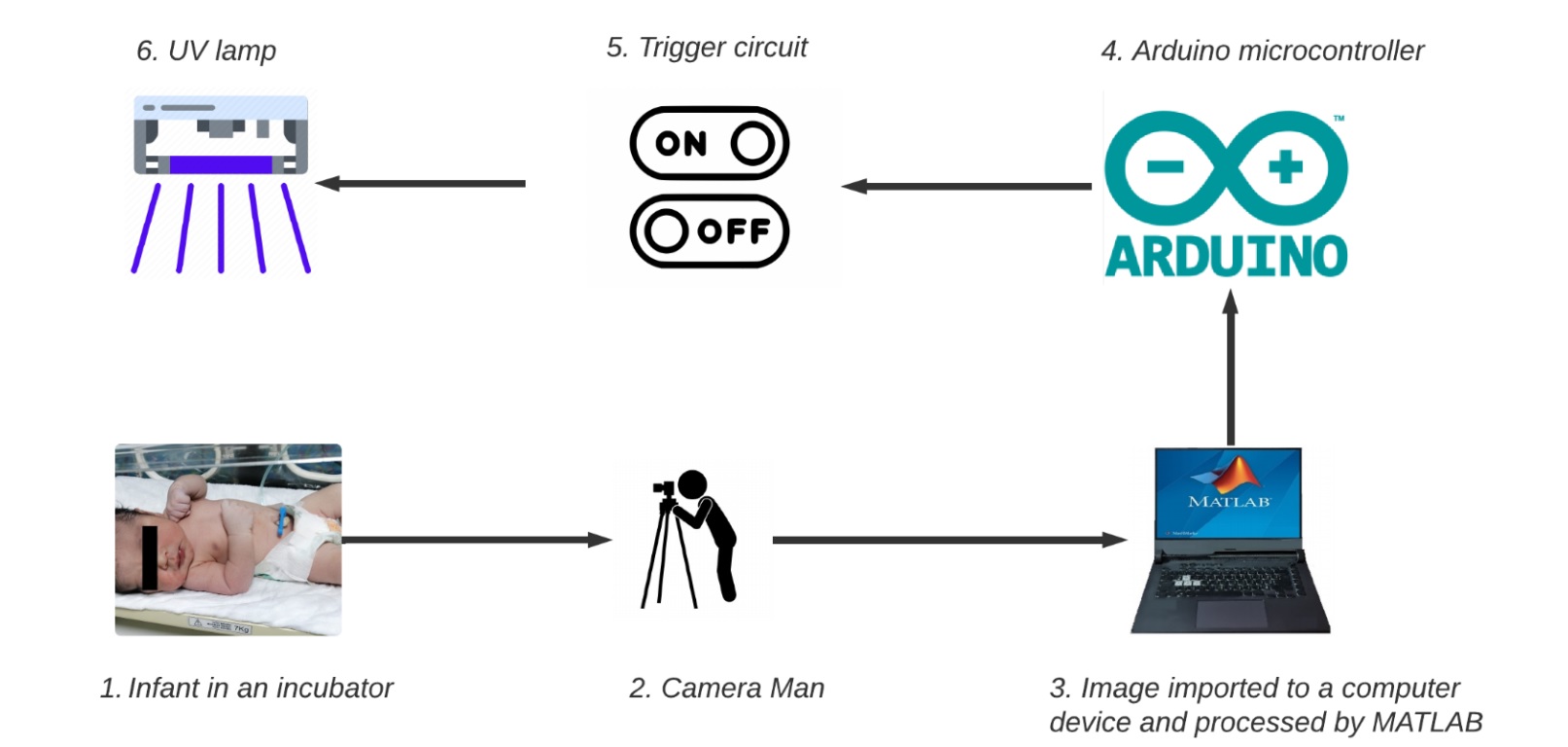Computer-Aid System for Automated Jaundice Detection
DOI:
https://doi.org/10.51173/jt.v5i1.1128Keywords:
Jaundice, Hyperbilirubinemia, Phototherapy, Skin Color Analysis, Random Forest AlgorithmAbstract
At the beginning of their lives, newborns may have a widespread condition known as Jaundice or Hyperbilirubinemia. High levels of bilirubin in the blood are the primary cause of jaundice. Severe cases of jaundice may cause acute bilirubin encephalopathy due to the toxicity of bilirubin to the cells of the brain, which may lead to kernicterus. Kernicterus causes several symptoms, including a permanent upward look, loss of hearing, and repetitive and uncontrolled movements. Therefore, diagnosing this condition at the appropriate time helps to prevent chronic effects. In this study, jaundice or hyperbilirubinemia is diagnosed using a computer vision system based on a random forest algorithm. The system comprises a digital HD camera, a computer device with a Matlab application installed to analyze and detect the skin color changes of the infant, and an Arduino Uno microcontroller to control an LED ultraviolet light. A set of neonate images were collected to train the random forest algorithm, including 374 for normal and 137 for jaundiced infants. |The experimental results using the random forest algorithm for classification reached an accuracy of 98.4375%. The results of this study are promising and open doors for new monitoring applications in various medical diseases detection with a high degree of accuracy.
Downloads
References
F. A. Dzulkifli, Y. Mashor, and K. Khalid, “Methods for Determining Bilirubin Level in Neonatal Jaundice Screening and Monitoring: A Literature Review,” J. Eng. Res. Educ., vol. 10, 2018.
H. Brits et al., “The prevalence of neonatal jaundice and risk factors in healthy term neonates at National District Hospital in Bloemfontein,” African J. Prim. Heal. Care Fam. Med., vol. 10, no. 1, pp. 1–6, 2018, doi:10.4102/phcfm.v10i1.1582.
V. K. Bhutani et al., “Neonatal hyperbilirubinemia and rhesus disease of the newborn: Incidence and impairment estimates for 2010 at regional and global levels,” Pediatr. Res., vol. 74, no. SUPPL. 1, pp. 86–100, 2013, doi:10.1038/pr.2013.208.
S. Mishra, R. Agarwal, A. K. Deorari, and V. K. Paul, “Jaundice in the newborns,” Indian J. Pediatr., vol. 75, no. 2, pp. 157–163, 2008, doi:10.1007/s12098-008-0024-7.
O. F. Pediatrics, N. Infant, and M. Weeks, “Weeks of Gestation BACKGROUND,” Pediatrics, vol. 114, no. 1, pp. 297–316, 2004, [Online]. Available: http://www.citeulike.org/group/11862/article/5941222
L. Mantagou, S. Fouzas, E. Skylogianni, I. Giannakopoulos, A. Karatza, and A. Varvarigou, “Trends of transcutaneous bilirubin in neonates who develop significant hyperbilirubinemia,” Pediatrics, vol. 130, no. 4, 2012, doi:10.1542/peds.2012-0732.
M. Mansouri, A. Mahmoodnejad, R. T. Sarvestani, and F. Gharibi, “A comparison between Transcutaneous Bilirubin (TcB) and Total Serum Bilirubin (TSB) measurements in term neonates,” Int. J. Pediatr., vol. 3, no. 3, pp. 633–641, 2015, doi: 10.21276/ajcpn.2018.6.4.4.
S. A. Alsaedi, “Transcutaneous Bilirubin Measurements Can Be Used to Measure Bilirubin Levels during Phototherapy,” Int. J. Pediatr., vol. 2018, pp. 1–5, 2018, doi:10.1155/2018/4856390.
S. Leartveravat, “Transcutaneous bilirubin measurement in full term neonate by digital camera,” Med. J. Srisaket Surin Buriram Hosp., vol. 24, no. 1, pp. 105–118, 2009.
M. N. Mansor et al., “Jaundice in newborn monitoring using color detection method,” Procedia Eng., vol. 29, pp. 1631–1635, 2012.
M. N. Mansor, M. Hariharan, S. N. Basah, and S. Yaacob, “New newborn jaundice monitoring scheme based on combination of pre-processing and color detection method,” Neurocomputing, vol. 120, pp. 258–261, 2013.
M. Aydın, F. Hardalaç, B. Ural, and S. Karap, “Neonatal jaundice detection system,” J. Med. Syst., vol. 40, no. 7, pp. 1–11, 2016.
W. Hashim, A. Al-Naji, I. A. Al-Rayahi, and M. Oudah, “Computer Vision for Jaundice Detection in Neonates Using Graphic User Interface,” IOP Conf. Ser. Mater. Sci. Eng., vol. 1105, no. 1, p. 012076, 2021, doi:10.1088/1757-899x/1105/1/012076.
W. Hashim, A. Al-Naji, I. A. Al-Rayahi, M. Alkhaled, and J. Chahl, “Neonatal jaundice detection using a computer vision system,” Designs, vol. 5, no. 4, pp. 1–17, 2021, doi:10.3390/designs5040063.
S. Chaudhary, Y. Arora, and N. Yadav, “Pr ep rin ot pe er re vie we d Pr ot pe er,” no. April, pp. 1–12, 2021.
N. T. Luu, T.-H. Le, Q.-H. Phan, and T.-T.-H. Pham, “Characterization of Mueller matrix elements for classifying human skin cancer utilizing random forest algorithm,” J. Biomed. Opt., vol. 26, no. 07, pp. 1–13, 2021, doi:10.1117/1.jbo.26.7.075001.
M. A. Wirth and P. Kovesi, “MATLAB as an Introductory Programming Language,” pp. 20–30, 2005, doi: 10.1002/cae.20064.
C. F. Van Loan and K.-Y. D. Fan, Insight through computing: a MATLAB introduction to computational science and engineering. SIAM, 2010.
S. Kolkur, D. Kalbande, P. Shimpi, C. Bapat, and J. Jatakia, “Human skin detection using RGB, HSV and YCbCr color models,” arXiv Prepr. arXiv1708.02694, 2017.
S. L. Bangare, A. Dubal, P. S. Bangare, and S. T. Patil, “Reviewing Otsu’s method for image thresholding,” Int. J. Appl. Eng. Res., vol. 10, no. 9, pp. 21777–21783, 2015.
M. A. H. M. Adib, M. H. A. Rahim, I. M. Sahat, and N. H. M. Hasni, “Pediatrics Technology Applications: Enhance the Bilirubin Jaundice (BiliDice) Device for Neonates Using Color Sensor,” in Recent Trends in Mechatronics Towards Industry 4.0, Springer, 2022, pp. 839–847.
J. Thongkam, G. Xu, and Y. Zhang, “AdaBoost algorithm with random forests for predicting breast cancer survivability,” Proc. Int. Jt. Conf. Neural Networks, pp. 3062–3069, 2008, doi:10.1109/IJCNN.2008.4634231.

Downloads
Published
How to Cite
Issue
Section
License
Copyright (c) 2023 Ahmad Yaseen Abdulrazzak, Saleem Latif Mohammed , Ali Al-Naji , Javaan Chahl

This work is licensed under a Creative Commons Attribution 4.0 International License.













